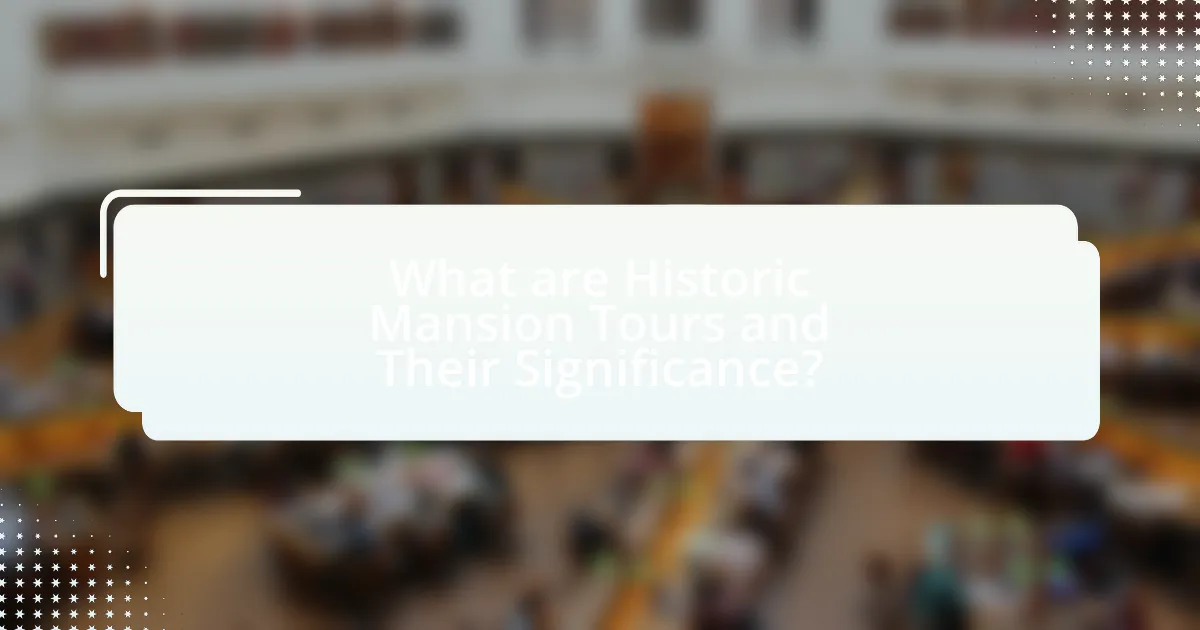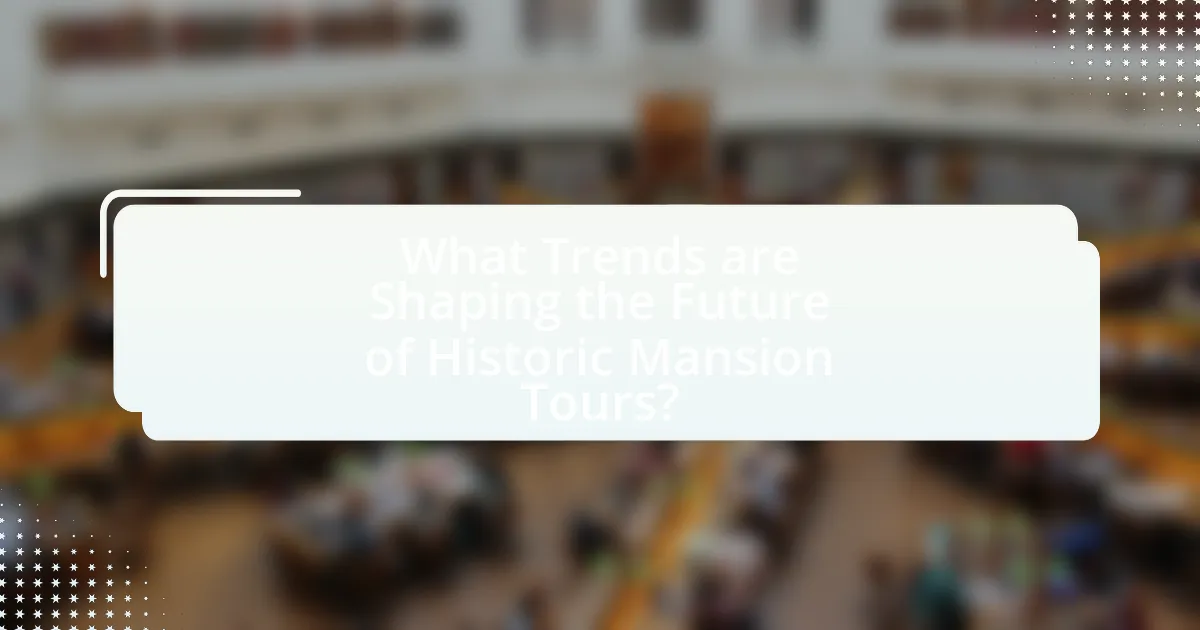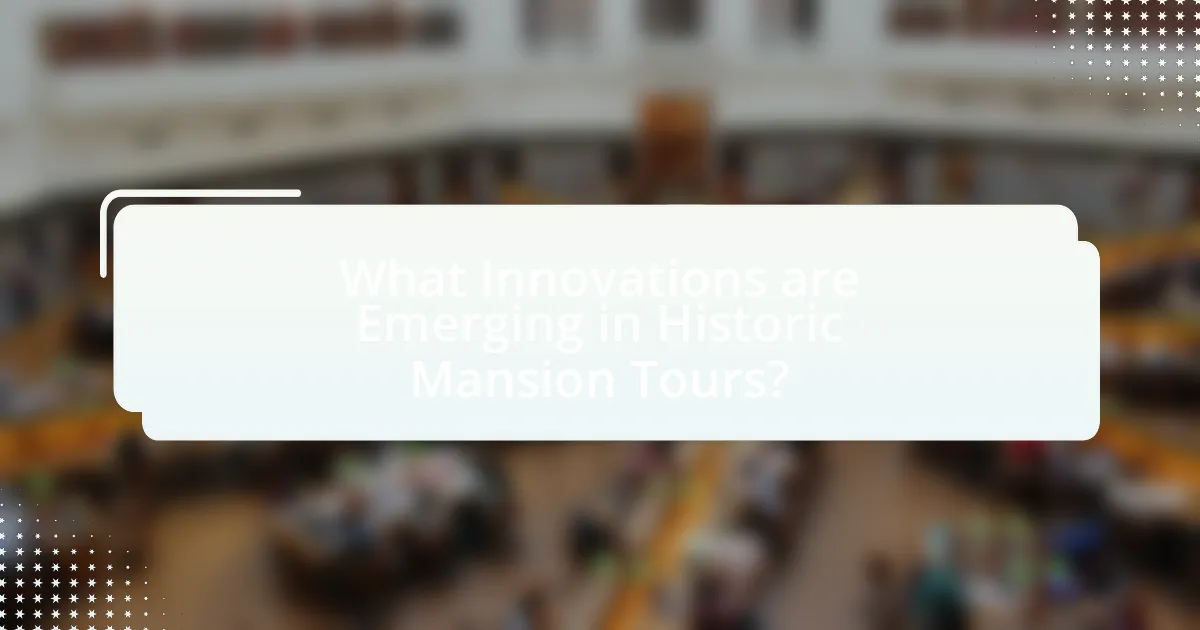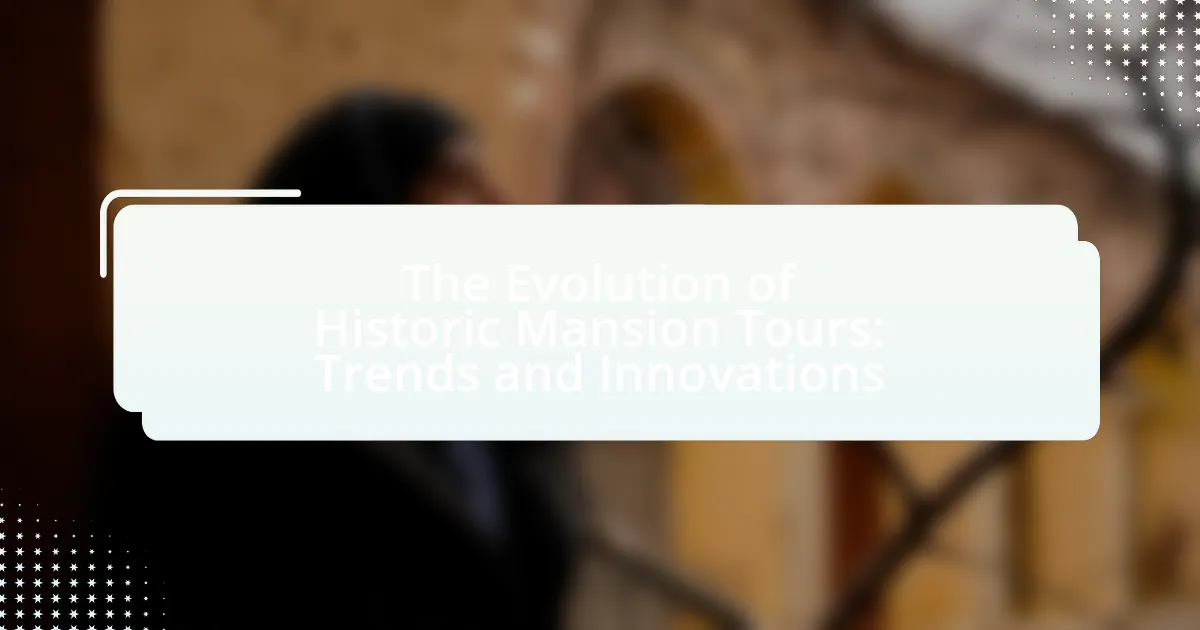Historic mansion tours are guided visits to historically significant residences that highlight architectural styles, cultural heritage, and the lifestyles of past inhabitants. This article explores the evolution of these tours, detailing their transition from formal, lecture-style experiences to interactive and immersive engagements enhanced by technology. Key historical events, such as the preservation movement and the rise of heritage tourism, have shaped the development of mansion tours, which now cater to diverse visitor demographics and expectations. The article also examines current trends, innovations in technology, and sustainable practices that are redefining the future of historic mansion tours, emphasizing their importance in preserving cultural heritage and contributing to local economies.

What are Historic Mansion Tours and Their Significance?
Historic mansion tours are guided visits to historically significant residences that showcase architectural styles, cultural heritage, and the lifestyles of past inhabitants. These tours provide educational insights into the history and significance of the mansions, often highlighting their role in local or national events. For example, many historic mansions, such as the Biltmore Estate in North Carolina, offer tours that reveal the opulence of the Gilded Age and the lives of influential families. The significance of these tours lies in their ability to preserve history, promote tourism, and foster appreciation for architectural heritage, as evidenced by the millions of visitors to historic sites annually, contributing to local economies and cultural awareness.
How have historic mansion tours evolved over time?
Historic mansion tours have evolved from exclusive, guided experiences focused primarily on architectural features and historical significance to more interactive and immersive experiences that engage visitors through technology and storytelling. Initially, tours emphasized the grandeur of the mansions and the lives of their former inhabitants, often delivered in a formal, lecture-style format. Over time, the introduction of audio guides in the 1980s allowed for a more personalized experience, enabling visitors to explore at their own pace.
In recent years, many historic sites have incorporated digital technology, such as augmented reality and virtual tours, to enhance visitor engagement and accessibility. For instance, the use of mobile apps provides additional context and interactive elements, allowing guests to visualize historical events and figures in the mansion’s setting. This shift reflects a broader trend in the tourism industry towards experiential learning and visitor participation, making historic mansion tours more relevant and appealing to diverse audiences.
What key historical events influenced the development of mansion tours?
Key historical events that influenced the development of mansion tours include the rise of the preservation movement in the 19th century, the establishment of the National Historic Preservation Act in 1966, and the growing interest in heritage tourism in the late 20th century. The preservation movement, sparked by figures like William Morris, aimed to protect historic buildings, leading to the creation of tours to educate the public about architectural and cultural heritage. The National Historic Preservation Act provided federal support for preserving historic sites, further promoting mansion tours as a means to engage communities with their history. Additionally, the increase in heritage tourism, driven by a desire for authentic cultural experiences, has made mansion tours a popular attraction, showcasing the historical significance and architectural beauty of these estates.
How have visitor expectations changed throughout the years?
Visitor expectations have evolved significantly over the years, shifting from a focus on passive observation to a demand for interactive and personalized experiences. Historically, visitors primarily sought informative tours that highlighted architectural features and historical facts. However, recent trends indicate that visitors now expect immersive experiences that engage them emotionally and intellectually, often incorporating technology such as augmented reality and interactive exhibits. According to a 2020 survey by the American Alliance of Museums, 75% of visitors expressed a desire for more hands-on activities and opportunities to participate in storytelling, reflecting a broader trend towards experiential learning in cultural institutions.
Why are historic mansion tours important for cultural heritage?
Historic mansion tours are important for cultural heritage because they preserve and showcase the architectural, historical, and social narratives of a community. These tours provide visitors with firsthand experiences of the lifestyles and values of past societies, allowing for a deeper understanding of cultural evolution. For instance, many historic mansions reflect specific architectural styles and construction techniques that are significant to regional history, such as the Georgian or Victorian styles prevalent in the United States. Additionally, these tours often include artifacts and stories that highlight the lives of notable figures associated with the properties, thereby enriching the cultural context. By engaging the public in this way, historic mansion tours foster appreciation for heritage conservation and promote educational opportunities that connect individuals to their cultural roots.
What role do these tours play in preserving history?
Historic mansion tours play a crucial role in preserving history by providing educational experiences that connect visitors to the cultural and architectural heritage of the past. These tours facilitate the conservation of historic properties, as they generate funding through ticket sales and donations, which can be allocated for maintenance and restoration efforts. For instance, the National Trust for Historic Preservation reports that heritage tourism contributes significantly to the preservation of historic sites, with millions of dollars raised annually for restoration projects. By engaging the public and fostering appreciation for historical significance, these tours ensure that the stories and legacies of past generations are not only remembered but actively preserved for future audiences.
How do mansion tours contribute to local economies?
Mansion tours contribute to local economies by generating revenue through tourism, which supports local businesses and creates jobs. For instance, visitors to mansion tours often spend money on nearby restaurants, hotels, and shops, thereby stimulating economic activity in the area. According to a study by the National Trust for Historic Preservation, heritage tourism, which includes mansion tours, can lead to a 10% increase in local economic activity. Additionally, mansion tours can attract visitors from outside the region, further enhancing the economic impact through increased spending and tax revenue.

What Trends are Shaping the Future of Historic Mansion Tours?
The future of historic mansion tours is being shaped by trends such as the integration of technology, personalized experiences, and sustainability. Technology, including virtual reality and augmented reality, enhances visitor engagement by allowing immersive experiences that bring history to life. Personalized experiences cater to individual interests, with tailored tours and interactive elements that resonate with diverse audiences. Sustainability practices, such as eco-friendly restoration and energy-efficient operations, are increasingly prioritized to appeal to environmentally conscious visitors. These trends reflect a broader shift towards enhancing visitor engagement and preserving cultural heritage while adapting to modern expectations.
How is technology impacting the experience of mansion tours?
Technology is significantly enhancing the experience of mansion tours by integrating interactive elements and providing immersive storytelling. Virtual reality (VR) and augmented reality (AR) applications allow visitors to visualize historical events and architectural details that may not be accessible in the physical space. For instance, some mansion tours now offer smartphone apps that provide audio guides, 3D models, and historical context, enriching the visitor’s understanding and engagement. According to a study by the National Trust for Historic Preservation, 70% of visitors reported a more enjoyable experience when technology was incorporated into tours, highlighting its effectiveness in enhancing visitor satisfaction and educational value.
What innovations in virtual tours are being implemented?
Innovations in virtual tours include the integration of augmented reality (AR), 360-degree video technology, and interactive storytelling elements. Augmented reality enhances user experience by overlaying digital information onto real-world views, allowing users to engage with historical context in real-time. The use of 360-degree video technology provides immersive experiences, enabling viewers to explore spaces as if they were physically present. Interactive storytelling elements, such as clickable hotspots and guided narratives, facilitate deeper engagement by allowing users to choose their own paths through the tour. These innovations are supported by advancements in mobile technology and internet connectivity, which have made high-quality virtual experiences more accessible to a broader audience.
How are mobile apps enhancing visitor engagement?
Mobile apps are enhancing visitor engagement by providing interactive experiences and personalized content during historic mansion tours. These applications allow visitors to access multimedia information, such as audio guides, augmented reality features, and detailed historical context, directly on their devices. For instance, a study by the National Trust for Historic Preservation found that 70% of visitors preferred using mobile apps for self-guided tours, as they offer flexibility and tailored experiences. Additionally, apps can facilitate real-time feedback and social sharing, further increasing visitor involvement and satisfaction.
What are the current trends in visitor demographics?
Current trends in visitor demographics indicate a growing diversity among attendees of historic mansion tours, with an increase in younger visitors and a more pronounced representation of multicultural backgrounds. Recent studies show that millennials and Gen Z now comprise a significant portion of visitors, driven by interests in experiential learning and social media engagement. Additionally, data from the National Trust for Historic Preservation reveals that 40% of visitors to historic sites identify as people of color, reflecting a shift towards inclusivity in cultural heritage tourism. This demographic evolution is reshaping how historic sites market themselves and curate experiences to appeal to a broader audience.
How are younger audiences influencing tour offerings?
Younger audiences are influencing tour offerings by demanding more interactive and immersive experiences. This demographic prioritizes engagement over passive observation, leading to the incorporation of technology such as augmented reality and virtual reality in tours. For instance, a study by the National Endowment for the Arts found that 72% of millennials prefer experiences that allow them to participate actively rather than just observe. Additionally, younger audiences favor personalized and themed tours that reflect their interests, prompting historic mansion tours to adapt by offering specialized events, such as ghost tours or art-focused experiences, to attract this demographic.
What changes are being made to accommodate diverse visitors?
Historic mansion tours are implementing changes such as multilingual guides, accessible facilities, and inclusive programming to accommodate diverse visitors. These modifications aim to enhance the experience for individuals from various cultural backgrounds, abilities, and age groups. For instance, providing materials in multiple languages ensures that non-English speaking visitors can fully engage with the content. Additionally, the introduction of wheelchair ramps and sensory-friendly tours caters to visitors with disabilities, promoting inclusivity. These efforts reflect a broader trend in the tourism industry to create welcoming environments for all, supported by research indicating that diverse programming can increase visitor satisfaction and engagement.

What Innovations are Emerging in Historic Mansion Tours?
Innovations emerging in historic mansion tours include the integration of augmented reality (AR) and virtual reality (VR) technologies, which enhance visitor engagement by providing immersive experiences. For instance, AR applications allow guests to visualize historical events or architectural details that are no longer present, while VR can transport users to different time periods within the mansion. Additionally, audio guides utilizing artificial intelligence personalize the tour experience by adapting content based on visitor interests and preferences. These advancements not only enrich the educational aspect of the tours but also attract a broader audience, as evidenced by a 2022 survey indicating that 65% of visitors prefer interactive experiences over traditional guided tours.
How are interactive experiences being integrated into tours?
Interactive experiences are being integrated into tours through the use of technology, such as augmented reality (AR) and virtual reality (VR), which enhance visitor engagement. For example, historic mansion tours now often include AR applications that allow guests to visualize historical events or figures in their original settings, providing a more immersive understanding of the site’s history. Additionally, interactive elements like touchscreens and mobile apps enable visitors to access detailed information, participate in quizzes, or even choose their own tour paths, thereby personalizing their experience. These innovations have been shown to increase visitor satisfaction and retention, as evidenced by studies indicating that interactive tours can boost engagement levels by up to 40%.
What types of hands-on activities are being offered?
Hands-on activities being offered include interactive workshops, guided reenactments, and immersive experiences that allow participants to engage with historical crafts and practices. These activities enhance visitor engagement by providing practical experiences related to the mansion’s history, such as period cooking, gardening, or traditional craftsmanship. Evidence of their effectiveness can be seen in visitor feedback, which indicates increased satisfaction and educational value when participants actively engage in these hands-on experiences.
How do immersive storytelling techniques enhance the tour experience?
Immersive storytelling techniques enhance the tour experience by creating a deeper emotional connection between visitors and the historical context of the site. These techniques engage multiple senses, allowing participants to visualize and emotionally resonate with the narratives being presented. For instance, the use of interactive elements, such as role-playing or augmented reality, can transport visitors into the past, making them feel as though they are part of the story. Research indicates that tours incorporating immersive storytelling can increase visitor retention of information by up to 50%, as participants are more likely to remember experiences that evoke strong emotions and personal connections. This approach not only enriches the educational aspect of the tour but also fosters a memorable and engaging atmosphere, ultimately enhancing overall visitor satisfaction.
What sustainable practices are being adopted in mansion tours?
Sustainable practices being adopted in mansion tours include the use of renewable energy sources, waste reduction initiatives, and eco-friendly materials in restoration efforts. Many historic mansions are now utilizing solar panels to power their facilities, significantly reducing their carbon footprint. Additionally, tour operators are implementing recycling programs and minimizing single-use plastics to decrease waste. Restoration projects often prioritize sustainable materials, such as reclaimed wood and low-VOC paints, to ensure environmental responsibility. These practices not only enhance the visitor experience but also contribute to the preservation of the environment, aligning with broader sustainability goals in the tourism industry.
How are historic sites reducing their environmental impact?
Historic sites are reducing their environmental impact by implementing sustainable practices such as energy-efficient lighting, water conservation systems, and eco-friendly materials in restoration projects. For instance, many historic sites have adopted LED lighting to decrease energy consumption, which can reduce electricity use by up to 75% compared to traditional incandescent bulbs. Additionally, rainwater harvesting systems are being installed to minimize water usage, allowing sites to utilize collected rainwater for landscaping and maintenance. These initiatives not only preserve the integrity of the historic structures but also contribute to broader environmental conservation efforts.
What role does community involvement play in sustainability efforts?
Community involvement is crucial in sustainability efforts as it fosters local engagement and ownership of environmental initiatives. When communities participate in sustainability projects, they contribute valuable local knowledge and resources, which enhances the effectiveness of these initiatives. For instance, research by the United Nations Environment Programme highlights that community-led projects often lead to higher success rates in conservation and sustainable practices, as local stakeholders are more invested in the outcomes. Additionally, active community participation can increase awareness and education about sustainability, leading to more sustainable behaviors among residents.
What Best Practices Should Be Considered for Future Mansion Tours?
Future mansion tours should prioritize visitor engagement, accessibility, and sustainability. Engaging visitors through interactive exhibits and storytelling enhances their experience and retention of information. Accessibility measures, such as providing audio guides and wheelchair access, ensure that all individuals can enjoy the tour. Sustainability practices, including energy-efficient lighting and eco-friendly materials, contribute to the preservation of both the mansion and the environment. According to the National Trust for Historic Preservation, incorporating these best practices can lead to increased visitor satisfaction and support for historic sites.
How can tour operators effectively engage with their audience?
Tour operators can effectively engage with their audience by utilizing personalized marketing strategies and interactive experiences. Personalized marketing, such as targeted email campaigns and social media engagement, allows operators to tailor their messages to specific audience segments, increasing relevance and connection. Interactive experiences, like virtual reality tours or live Q&A sessions with historians, enhance audience involvement and create memorable connections to the historic mansion tours. Research indicates that 80% of consumers are more likely to make a purchase when brands offer personalized experiences, demonstrating the effectiveness of these engagement strategies.
What strategies can enhance the educational value of tours?
Incorporating interactive elements significantly enhances the educational value of tours. Strategies such as using augmented reality (AR) to provide immersive experiences allow participants to visualize historical events and figures in real-time, thereby deepening their understanding. For instance, a study by the University of Southern California found that AR applications in educational settings increased retention rates by up to 40%. Additionally, engaging expert guides who can share in-depth knowledge and personal anecdotes fosters a more relatable and informative experience. Research from the National Trust for Historic Preservation indicates that tours led by knowledgeable guides result in higher visitor satisfaction and learning outcomes. Implementing pre- and post-tour educational materials, such as worksheets or discussion prompts, also reinforces learning by encouraging reflection and critical thinking about the content presented during the tour.

Leave a Reply